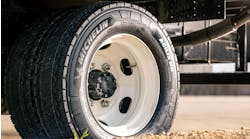Now that winter has set in, drivers typically start paying more attention to the tread depth on their tires, particularly the ones in the drive positions. Tire dealers always look forward to the first real snowfall when all of the trucks with marginal tires get stuck or have a harder time dealing with unplowed surfaces. It may seem a little morbid, but bad winter weather typically translates into more tire sales, so those in the tire industry love waking up to a fresh layer of the fluffy white stuff.
According to the Federal government, the minimum tread depth on commercial vehicles is 4/32 of an inch on steer tires and 2/32 of an inch on all other positions. Contrary to what some may believe, the regulation specifically states that a vehicle will not pass inspection if the tread depth is below the legal limits “when measured at any point on a major tread groove.” That means one thin spot or one wear bar that is worn evenly with the tread on either side is enough to receive a citation.
But insufficient tread depth has additional consequences. Studies have shown that as the tire wears down toward that 4/32 mark, the stopping distance required on wet surfaces steadily increases. Once the tread depth passes 2/32, the additional room that may be necessary to stop 80,000 lbs. may be the difference between a routine stop and a rear-end collision. It's definitely a double-edged sword because, on one hand, the fleet feels the need to squeeze out every mile-per-thirty-second of tread depth it can get, but tires with marginal or “illegal” tread depth can also be a smoking gun in the event of an accident.
Retreadability is also affected by the amount of tread depth that remains on the tire prior to retreading. In the case of a new tire that will ultimately become a “virgin” casing, I've personally seen hundreds of casings rejected because the fleet ran the tire all the way down to the 2/32 limit. It really is the perfect example of being penny-wise and dollar-foolish because the cost-per-mile difference between a new tire and a retread is widening with every price increase. If fleets want to preserve their casings and control tire costs, they must work with their retread vendors to ensure that the pull-point protects the integrity of the casing.
It's also important to note that fuel-efficient tires and retreads typically have more shallow tread depths, so there is less rolling resistance. This means the fleet may have to balance the gains in fuel mileage against the potential loss of miles-per-thirty-second. While there have been some rumors regarding the decreased stopping ability of these new fuel-efficient compounds, there is no data to support the fact that low rolling resistance tires and retreads stop better or worse than their standard counterparts.
Finally, fleets must recognize that tread depth can be severely impacted when dual tires are not matched. It's hard to justify two new tires when only one is needed, but a mismatched set of duals creates a number of problems. First, the larger tire carries more weight, which makes it more susceptible to an overload situation and causes it to wear faster. And second, the smaller tire ends up skipping on the pavement to keep up with the larger tire, so it typically develops an irregular treadwear pattern. The general rule is to ensure that the tread depth between dual tires does not vary by more than 4/32 of an inch.
Kevin Rohlwing can be reached at [email protected]


